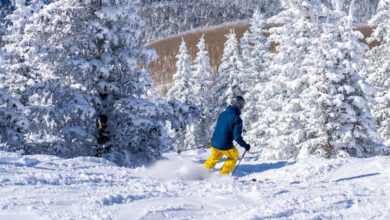Learn a Modern Solo Guitar Arrangement of the Classic Cowboy Ballad “When the Work’s All Done This Fall”
Welcome to Non-Traditional, a new song department where contemporary guitarists offer fresh takes on old songs.
Originally composed in the late 1890s by cowboy poet, composer, and horse wrangler D. J. O’Malley, “When the Work’s All Done This Fall” is a classic ballad that details the longing of a young cowboy to return home when his work is completed on the range. In a tragic accident during a stampede, he is swiftly killed, then put to rest the following morning in an unmarked grave.
Included in the original 1910 printing of musicologist and folklorist John Lomax’s seminal book Cowboy Songs and Other Frontier Ballads, this song has taken many forms throughout the last 100 years of recorded history. The original 1924 78 RPM record by Fiddlin’ John Carson set the format for these kinds of performances, while Carl T. Sprague’s hit version the following year sold over 150,000 copies. More contemporary versions from guitarists like Norman Blake and singer-songwriters such as Colter Wall are all singular, yet each upholds the tradition of the tune.

Old songs like “When the Work’s All Done This Fall,” which originated as poems, were commonly set to popular melodies of the day; Carson’s version, for instance, borrowed the melody from “After the Ball.” In this way, placing these tunes within instrumental arrangements yields an opportunity to investigate—and manipulate—the bedrock American music that comprises so much of the material we digest to this day.
The arrangement presented here honors the original melody of “When the Work’s All Done” while rendering it with a flatpicking approach that nods toward more contemporary figures like Clarence White. (It could alternatively be played fingerstyle.) Most of the piece is conducive to straight flatpicking. However, in instances where notes are played simultaneously on nonadjacent strings, as in measures 3, 6–7, etc., it’s best to use a hybrid picking approach, with a pick on the lower notes and your middle or ring finger—whichever is more comfortable—plucking the higher notes. Considering the fact that players from the 1920s (such as Mother Maybelle Carter, Jimmie Rodgers, and Dick Justice) used various techniques and combinations of thumb- and fingerpicks, this polyphonic approach can get us closer to the original songsters of the day, while the flatpicking idiom provides us with modern perspectives, language, and techniques.
Open strings play a crucial role in this arrangement. The first (E), second (B), fifth (A), and sixth (E) strings are all notes found in the key of E major, so whenever one is available for a melody or chordal note, I use it instead of its fretted counterpart, in the interest of textural contrast. Open strings can also make it easier to move between different regions of the fretboard, as in measures 7 and 8.
You will notice that in the four-measure intro and at the ends of phrases, standard open cowboy chords like E and A give the arrangement a homespun quality. Keeping this feel coursing throughout, blending single notes and strums with even dynamics, is paramount for delivering a convincing and expressive performance.

This article originally appeared in the May/June 2024 issue of Acoustic Guitar magazine.




